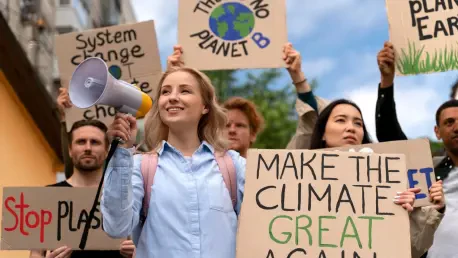In the heart of Belem, Brazil, an Amazonian city pulsating with cultural and environmental significance, tens of thousands gathered during the COP30 UN Climate Change Conference for the “Great People’s March.” This demonstration, the first major protest at a UN climate summit since COP26 in Glasgow, underscored a global outcry against stalled climate negotiations. With the world watching, activists, Indigenous groups, and concerned citizens united to demand climate justice, a fossil fuel phase-out, and reparations for environmental damages. This roundup compiles diverse perspectives from participants, observers, and policy analysts to unpack the significance of this historic march, exploring what it reveals about the state of global climate action and the growing impatience with diplomatic gridlock.
Unpacking the Protest: Diverse Voices on Climate Urgency
Frustration with Slow Progress: A Shared Sentiment
Among the myriad voices at the Belem march, a common thread emerged: frustration with the lack of tangible outcomes at COP30. Many participants, including grassroots organizers, expressed dismay at the midpoint of negotiations, pointing to the absence of breakthroughs as evidence of systemic inertia. Reports from attendees highlighted a palpable anger toward global leaders for failing to prioritize vulnerable communities already grappling with climate impacts.
Observers of international climate policy echoed this sentiment, noting that divisions over trade measures, weak emissions targets, and insufficient financial aid for poorer nations have deepened the deadlock. Some analysts suggest that this frustration reflects a broader disconnect between the urgency felt by the public and the slow pace of diplomatic processes. The question remains whether such public outcry can translate into pressure for meaningful commitments.
This collective exasperation, voiced through chants and banners, painted a vivid picture of a populace tired of promises without action. The march became a platform for those outside the conference halls to demand accountability, emphasizing that time is a luxury the planet can no longer afford. Their message was clear: incremental steps are no longer sufficient in the face of escalating crises.
Fossil Fuel Phase-Out: Symbolism Meets Policy Debate
A striking element of the protest was the call for a complete phase-out of fossil fuels, symbolized by a mock funeral procession with coffins labeled “coal,” “oil,” and “gas.” Participants described this act as a powerful visual critique of industries perpetuating environmental destruction. Many activists argued that such symbolism was necessary to jolt policymakers into recognizing the dire need for rapid energy transitions.
Contrasting views emerged among energy sector commentators, with some acknowledging the emotional resonance of these displays while questioning their practicality. They pointed to entrenched corporate interests and governmental reliance on fossil fuels as significant barriers to swift change. Yet, advocates at the march countered that delaying transitions only exacerbates harm to communities on the frontlines of climate change, as depicted by a giant beach ball representing Earth, rolled through Belem’s scorching streets.
The debate over timelines for phasing out dirty energy continues to polarize opinions. While protesters pushed for immediate action, some policy experts emphasized the need for structured plans to avoid economic disruption. This clash of perspectives underscores a critical tension: balancing urgency with feasibility remains a formidable challenge in climate discussions.
Indigenous Representation: A Call for Inclusion
Indigenous groups, particularly from the Amazon region, played a central role in the Belem march, advocating for the protection of their lands and greater representation at COP summits. Their presence in an Amazonian city amplified their message, with many participants stressing that the destruction of vital ecosystems like the rainforest cannot be ignored. Their plea was not just for preservation but for a seat at the decision-making table.
Regional advocates and environmental scholars supported this stance, arguing that Indigenous knowledge offers invaluable insights into sustainable practices often overlooked in global talks. They highlighted earlier disruptions by Indigenous representatives inside the COP30 venue as evidence of growing unrest with being sidelined. The consensus among these voices is that excluding such perspectives undermines the effectiveness of climate strategies.
Differing opinions exist on how to integrate Indigenous input into formal negotiations. Some policy analysts suggest structured frameworks for inclusion, while others warn of tokenism if representation lacks real power. This diversity of thought reveals a broader struggle to redefine who shapes climate solutions, with the march serving as a reminder that local voices hold critical stakes in global outcomes.
Global Solidarity: Symbols Bridging Diverse Struggles
The march also showcased remarkable unity across cultures, with symbols like a giant Palestinian flag and banners reading “Our future is not for sale” linking climate issues to wider inequities. Participants from varied backgrounds, including Ecuadorean Waorani people and international activists, described a shared sense of purpose despite their distinct grievances. Their chants and dances blended outrage with hope, creating a tapestry of resistance.
Cultural analysts observing the event noted that such cross-border alliances highlight the interconnected nature of climate justice with other social struggles. They argue that these displays of solidarity could inspire a more holistic approach to environmental policy, addressing systemic inequalities alongside ecological concerns. However, some skeptics question whether such diverse coalitions can maintain momentum beyond symbolic gestures.
The range of symbols and participants at the march painted a complex picture of global discontent. While many celebrated the unity, others pondered the challenge of translating this energy into concrete policy influence. This spectrum of views illustrates both the potential and the hurdles of forging lasting movements from such powerful, yet varied, expressions of dissent.
Key Takeaways from Belem’s Climate March
Reflecting on the “Great People’s March,” several lessons stand out from the chorus of opinions gathered. The central demands for climate justice, fossil fuel elimination, and reparations resonated as a unified cry for accountability from governments and corporations alike. Participants and analysts largely agreed that the passion on Belem’s streets exposed a critical gap between public urgency and political inaction.
Differing suggestions for next steps emerged, with many grassroots voices urging amplified Indigenous representation in climate talks to ensure equitable solutions. Policy observers advocated for supporting local movements as a way to sustain pressure on decision-makers, while some emphasized the need for clearer financial commitments from wealthier nations. These varied insights point to a multifaceted path forward, blending representation with actionable policy reform.
The event also sparked discussions on how public demonstrations influence global summits. While some saw the march as a catalyst for change, others cautioned that without sustained engagement, such protests risk being dismissed as fleeting outbursts. This roundup of perspectives ultimately highlights the complexity of translating street-level energy into lasting impact, setting the stage for deeper exploration of climate advocacy strategies.
Reflecting on a Historic Moment
Looking back, the “Great People’s March” in Belem during COP30 stood as a defining moment of public dissent against the backdrop of stalled climate negotiations. It brought together a diverse array of voices, from Indigenous communities to international activists, each contributing to a powerful narrative of urgency and solidarity. The event exposed deep frustrations with the pace of global action and underscored the necessity of inclusive, equitable approaches to environmental challenges.
Moving forward, the challenge lies in harnessing this momentum to drive systemic change. Supporting grassroots initiatives, advocating for stronger national climate commitments, and ensuring marginalized voices shape policy discussions emerged as critical steps from the insights gathered. Exploring further resources on climate justice movements and engaging with local advocacy efforts can help sustain the energy witnessed in Belem, pushing for a future where rhetoric transforms into reality.









